|
|
 |
Pinzgauer in USA
Early US Pinzgauer History
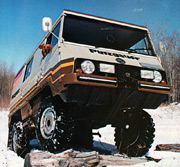
|
In 1977, Steyr-Daimler-Puch started its first attempt to put a civilian Pinzgauer model on the US market. The famous "Car and Driver" motoring
journalist David E. Davis Jr. agreed at a meeting with the management of SDP of America and with Dr. Egon Rudolf and Dipl.-Ing. Heinz Ahlgrimm (both from the
Pinzgauer business in Graz) to drive a Pinzgauer for a year on trial basis to evaluate it as a recreational vehicle. Later the same year, the vehicle
shown to the left was specially made for the Car and Driver magazine. Picture: Car and Driver July 1978.
|
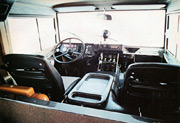
|
In January 1978, the vehicle arrived in the United States. Compared to military versions, it had a civilian paint scheme and an upgraded grille with extra
driving lights. The interior was also upgraded and many extras were fitted, such as for example a gasoline heater and a Blaupunkt radio. Picture: Car and Driver July 1978.
|
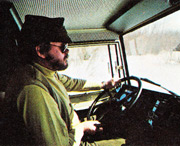
|
In July 1978, David E. Davis Jr. (shown to the left in the tested Pinzgauer) published a nine-page article with many pictures in the
Car and Driver magazine. Picture: Car and Driver July 1978.
|
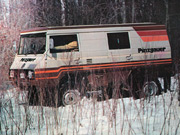
|
Even though Mr. Davis was obviously very enthusiastic about the Pinzgauer and managed to paint a very positive picture in his Car and Driver article,
he already had to admit that the price of the vehicle would be much higher compared to typical US-made four wheel drive vehicles. According to his
opinion "the Pinzgauer buyer would be someone who really needs the vehicle's off road abilities or someone who is rich as Croesus and decides he
can't live without it". Picture: Car and Driver July 1978.
|
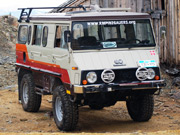
|
Based on the feedback from the "Car and Driver" Pinzgauer, it appears that Steyr-Daimler-Puch built at least two more prototypes for the US-market.
As you can see in the picture to the left, the configuration includes eight extra windows, special front grille, fresh air flaps, side marker lights and a fuel tank
that has been moved to the rear compartment (note the filler behind the rhs rear door). Picture: Per Eliasen.
|
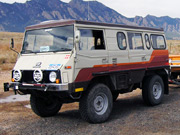
|
The vehicle shown to the left belongs to Per Eliasen in Colorado, USA. Fabricated in 1978, it seems that the Pinzgauer was originally not exported to the US and remained
at the Graz factory until 1983, possibly due to the reason that not even a small scale dealer network could be established in the United States. Picture: Per Eliasen.
|
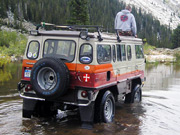
|
In 1983, a man named Dr. Robert Baker, who was mainly dealing with used G-Wagens and Haflingers, bought the Pinzgauer from the factory and imported
it into the United States. Later on, in 1992, Per Eliasen found the truck and finally acquired it in 1997. Picture: Per Eliasen.
Reportedly, the second US-prototype with similar specification was sold to a customer in southern Germany. Any information about this vehicle
would be very welcome to be included here.
|
Pinzgauer of America
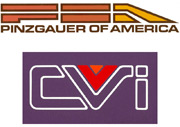
|
In 1980, Mr. Ed Russell, a wealthy Texan, agreed with Steyr-Daimler-Puch to evaluate the Pinzgauer based on some demonstrator vehicles and
to rework it to American tastes. Russell was already known for his company "CVI" (Custom Vehicles Incorporated), that was producing
special edition Scouts close to the International Harvester Scout factory in Ft. Wayne, Indiana. In 1981, he founded "Pinzgauer of America"
as a division of CVI in Arlington, Texas. Pictures: Dick Nesbitt and Pinzgauer of America brochure.
|
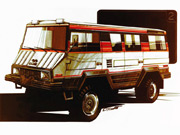
|
At that time, the talented designer Richard Nesbitt was working as Chief of Design for Russell's special edition Scouts. He also took the same role
in Pinzgauer of America and came up with a design proposal for a civilian US-version of the Pinzgauer. Steyr-Daimler-Puch had provided a base
vehicle in 1980 (see further below), that was used as a starting point for Nesbitt's design. Picture: Dick Nesbitt.
|
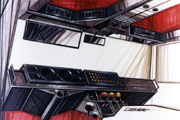
|
Apart from the special exterior with wheel arches, body trim, extra windows and many other details, the main focus was set on developing a more
comfortable and classy design for the interior. Picture: Dick Nesbitt.
|
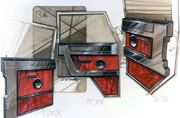
|
Detailed design studies were also made for the doors, as shown to the left. Picture: Dick Nesbitt.
|
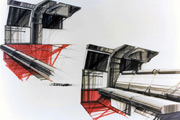
|
And for the rear compartment, that included three foldable seats. Picture: Dick Nesbitt.
|
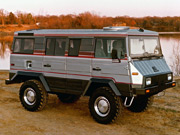
|
The final outcome was the Pinzgauer shown to the left. Note how close the vehicle comes to Dick Nesbitt's original drawing. With its square headlights
and straight lines, the front grille was customized to match well with the rest of the Pinzgauer's overall design. Wide mud-terrain tyres on Centra rims
complete the new look for the US market. Picture: Dick Nesbitt.
|
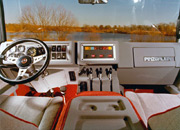
|
As mentioned above, the interior was also extensively modified with comfortable Recaro seats, carpentry, sports steering wheel and a dashboard with new layout
as well as with extra instruments. The rear compartment (picture below) underwent a similar series of upgrades with carpentry and more comfortable passenger seats.
Note the overhead air conditioning system. Picture: Dick Nesbitt.
|
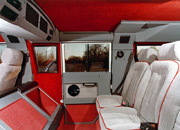
|
Even though the design of this prototype looked very promising, it seems that with a price tag of approximately 30,000 to 50,000 US Dollars, the
Pinzgauer could not be established on the US market. It appears that only the one demonstrator vehicle shown to the left was made. Picture: Dick Nesbitt.
|
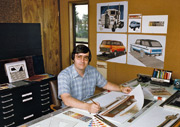
|
Finally a picture of Dick Nesbitt himself in his office in 1981. He was also responsible for the design of the "CVI" and "POA" logos,
that can be seen in the background in the photo to the left. I would like to thank Dick Nesbitt for letting me use his drawings and pictures for this article!
Picture: Dick Nesbitt.
|

|
Two more interesting pictures shall be presented in this context: These were published together with a short article in the German Off Road magazine 04/1980.
According to Dick Nesbitt, the photos show the Pinzgauer that was used as a basis for the re-designed US prototype. Steyr-Daimler-Puch already had provided
a vehicle with extended wheel arches, body trim etc., that later on underwent further modifications to become the Pinzgauer shown above. Picture: Off Road 04/1980.
|
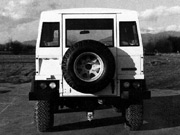
|
As indicated by the badges on the vehicle, a turbocharged version of the Pinzgauer engine with 2.7 liter displacement and Bosch K-Jetronic fuel injection system
was fitted. It provided more power compared to the standard 2.5 l naturally aspirated gas engine with carburetors and thus matched well with the demands on the
US market. Picture: Off Road 04/1980.
|
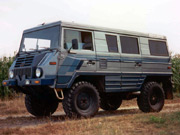
|
It seems that after the US demonstrator vehicle was produced by Ed Russell's Pinzgauer of America, it was sent back to the Steyr-Daimler-Puch factory in Graz
for further factory evaluation and re-tooling of the production line. However, since the vehicle never made it into series production, the prototype was
apparently abandoned and possibly sold to private hands in Austria.
The picture to the left very probably shows the Pinzgauer after having undergone a repaint, among other modifications. A hood of the later turbodiesel
Pinzgauers was fitted, but without any function. Any further information about the remains of this vehicle would be very interesting. Picture: User
"moonracer" at Real 4x4 Forums.
|
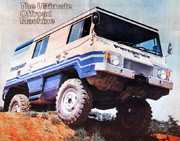
|
While the sophisticated US demonstrator vehicle was sent back to the factory in Austria for re-tooling, Ed Russel had at least one more civilian Pinzgauer
available for testing, that is shown in the photo to the left. It was presented in an article in the
Autoweek Magazine, edition 7/1982.
|
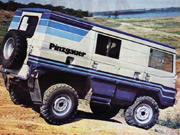
|
Note that this Pinzgauer also has some special specifications, such as the second fuel tank in the rear compartment (second filler nozzle behind rear door).
Picture: Autoweek Magazine 7/1982.
|
Pinzgauer of North America
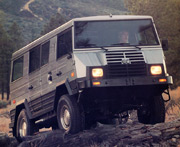
|
In 1986, Steyr-Daimler-Puch started another attempt to market the Pinzgauer in the United States, this time the freshly developed turbodiesel version.
At least two US demonstrator vehicles of the type shown to the left were produced at the factory in Graz. Note that the overall design is actually very close
to the one that was developed a few years earlier by Dick Nesbitt. Picture: Pinzgauer of North America brochure.
|
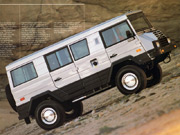
|
A company called "Pinzgauer of North America, Inc." was founded by Mr. Robert A. Miller in Telford, Pennsylvania. In February 1986, he invited
possible qualified dealers to an introduction event for the new Pinzgauer, which took place along with the NADA (National Automobile Dealers
Association) Convention in New Orleans (see: Invitation).
Picture: Pinzgauer of North America brochure.
|
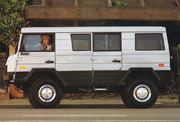
|
Highlight of the Pinzgauer presentation was a test drive on a specially prepared test track in La Place, north of New Orleans. The invitees were flown there
by helicopter from the NADA Convention. Representatives of the Steyr-Daimler-Puch factory in Graz were also on-site to ensure the success of the presentation.
Picture: Pinzgauer of North America brochure.
|
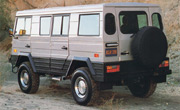
|
There also exists an interesting Pinzgauer of North America brochure, that contains
the pictures of the vehicle shown to the left. Picture: Pinzgauer of North America brochure.
|
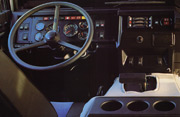
|
Even though the basic technical concept of the Pinzgauer remained the same, the turbodiesel version came with many new features. These included e.g. an automatic
gearbox and electropneumatic actuation of four wheel drive and differential locks.
A 2.4 liter in-line 6 cylinder Volkswagen engine with 110 hp was fitted into these first generation turbodiesel Pinzgauers. Picture: Pinzgauer of North America brochure.
|
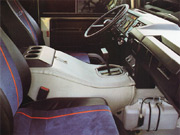
|
Similar to the older US demonstrator vehicle, five comfortable single seats were fitted to this turbodiesel Pinzgauer (see also picture below).
Note the freshly designed upholstery with Puch branding. Picture: Pinzgauer of North America brochure.
|
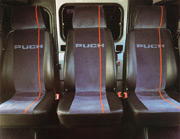
|
Again, it obviously was the very high price of the Pinzgauer that kept the vehicle from having success on the US market. It seems that "Pinzgauer of
North America" went out of business soon after the introduction of the Pinzgauer at at the NADA Convention. Picture: Pinzgauer of North America brochure.
|
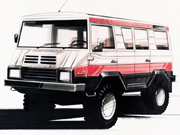
|
The picture to the left shows the original design of the turbodiesel US demonstrator Pinzgauers. It was drawn by Friedrich Spekner, then Chief
of Design at Steyr-Daimler-Puch in Graz. Note that even though Spekner didn't know Nesbitt, he obviously adopted many ideas from the older gas Pinzgauer
design. Picture: Friedrich Spekner/Pinzgauer of North America Presentation invitation.
|
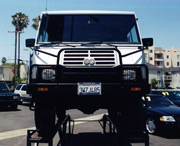
|
After the unsuccessful end of "Pinzgauer of North America" in Telford, Pennsylvania, one of the demonstrator vehicles that is shown to the left
ended up with a company called "Europa" in Santa Fe, New Mexico. The company was known for importing G-Wagens into the United States, before
Mercedes-Benz of USA started importing them officially.
|
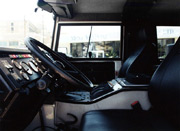
|
Europa sold the truck to Arnold Schwarzenegger, who owned it for two or three years. Afterwards, in the early 90s, the Pinzgauer was offered at a Mercedes-Benz
dealership in Beverly Hills, L.A., where the pictures to the left were taken. Note that the seat cushions look different compared to the ones in the brochure
pictures. So possibly, this vehicle is not the demonstrator that was shown in the brochure.
|
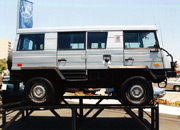
|
It is also interesting to note, that on this Pinzgauer, the body trim and the wheel arches have obviously been modified, possibly to replace damaged parts or
to alter the overall design. Sadly, I do not recall where on the internet I found these three interesting photos, so I cannot credit the photographer properly.
If anyone knows more about these pictures and/or the photographer, please don't hesitate to get in contact.
|
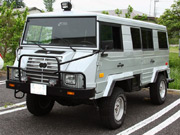
|
It appears that the Pinzgauer shown above was later on sold to a car museum in Japan. Again, the vehicle was modified including new paint and new tires,
but it clearly is the same Pinzgauer. Picture: Takashi Koga at CarKingdom.
|
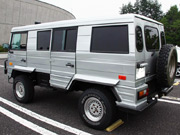
|
The Pinzgauer seems to be still in possession of the Nasu PS Garage
car museum in Japan. The museum is located near the city of Nasushiobara. Picture: Takashi Koga.
The second demonstrator vehicle of the same type somehow made its way to England, where it still remains. I hope to be able to include some photos
of this Pinzgauer here in the future.
|
US Special Forces Pinzgauers
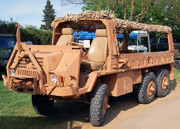
|
Besides the endeavour to sell the Pinzgauer on the civilian market, Steyr-Daimler-Puch also tried to acquire military and public authorities as customers.
It proved to be a main problem that vehicle supply contracts with these kind of buyers required an added value of 50 per cent or more inside the United States.
Even with local assembly, this would have been impossible to realize with the Pinzgauer.
Picture: Scott Ingham, Expedition Imports.
|
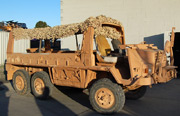
|
However, the US Special Forces were not limited by these restrictions and decided to buy a few dozens of Turbo D Pinzgauers for their purposes. It appears that
at least some of these were delivered as 716 M 4x4 and later on converted to 6x6, while others came as original 718 M models. Picture: Brian Mason.
|
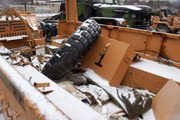
|
These Pinzgauers (sometimes also referred to as "SOCOM", i.e. "Special Operations Command" Pinzgauers) were for example used for United States
special operations in Iraq in 1991 and in 2003. Picture: Brian Mason.
|
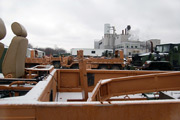
|
Meanwhile, most or all of the Pinzgauers went to dealers and private hands through government liquidation auctions that took place at the Wright-Patterson Air
Force Base in Dayton, Ohio in late 2010 and early 2011. The picture to the left and the picture above were taken when the vehicles were up for the auction
in Ohio. Picture: Brian Mason.
|
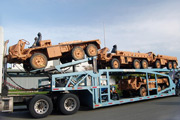
|
Another photo showing US Special Forces 718 M Pinzgauers after government liquidation on their way from Ohio to Expedition Imports in Vallejo, CA.
Picture: Brian Mason.
|
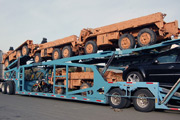
|
There exist some interesting websites with further information about these special Pinzgauers:
Picture to the left: Brian Mason.
|
|









